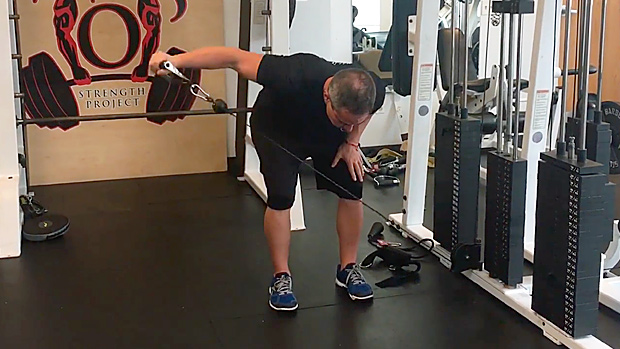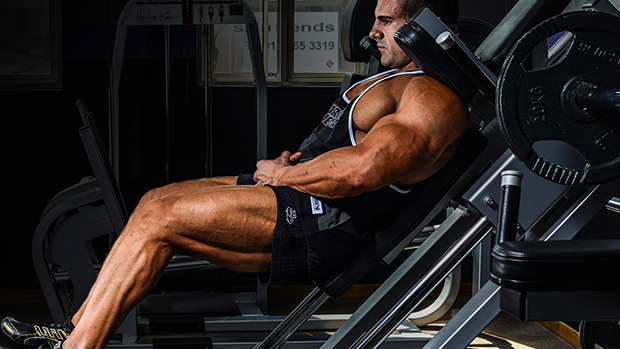Getting bigger and stronger requires dedication, persistence and lots of hard work. So, let's just forget about all that nonsense and pull out some Jose Cuervo.
Nah, just kidding.
As you know, hard work isn't enough. You need to know how to execute the right plan at the right time and see it through to the end.
While high volume training isn't necessary for novice trainees, it's absolutely necessary for advanced lifters to get bigger and stronger. High volume training isn't the only effective method of training, but it's a form of training that needs to be applied at some point to successfully take your physique to the next level.
I'm going to go over the pitfalls of doing volume training incorrectly, then show you how to personalize high volume training to your unique body type for maximum gains in size and strength.
Pump Up The Volume
Why even bother with high volume training? After all, isn't high intensity (low volume) training effective and less time consuming?
Sure, high intensity training takes less time, but it isn't more effective for building size and strength. For one thing, low volume doesn't give you the pump that high volume training does. Why is the pump important? According to T-Nation strength coach Christian Thibaudeau, "If all you want is to gain quality muscle size and lots of it, achieving a good pump is important."
The most effective way to get the best pumps is to use high volume with heavy weights. Forget about doing one hundred pushups to get a pump. That isn't what we're after. We want pumps from heavy weight for maximum muscle growth.
Six High Volume Mistakes
Let's go over several mistakes that people make when applying high volume training programs:
1 – Too Much, Too Often
The first mistake is doing too much work too often. You can't do fifteen sets for legs on Monday and expect to be able to hit legs again on Wednesday. Chances are high that you'll need three to five days off between each muscle group depending on the intensity of the workout and your recovery abilities.
This doesn't mean you hit legs on Monday and don't train again until Friday. It means that you don't work legs again until Friday. Do some other muscle groups on Tuesday and Wednesday.
There's an inverse relationship between frequency of training and volume of training. In other words, the more work you do in the gym, the less often you can go to the gym. High volume requires a lower frequency of training and a higher frequency of rest days.
2 – Poor Planning
Simply going to the gym and doing four to five different exercises for one body part isn't proper planning. You can't improve on several exercises at the same time. Also, once you hit a muscle group hard with a compound exercise such as the bench press or squat, there's really no need to follow up with three to four more exercises for that same body part.
I see trainees all the time do four sets on the bench press, followed by four sets on the incline press, and yet another four sets on the decline press. If that isn't enough, they'll go on to cable crossovers and dumbbell flyes. Do you really think it's necessary to hit the chest with so many exercises? I don't think so. The chest doesn't have ten different parts that need to be addressed by a variety of drills. Just focus on one or two exercises that activate the most muscle fibers in the area and move on.
3 – Using an Unbalanced Program
Many male lifters will do ten to twenty sets for the chest and biceps but only two or three sets of leg extensions and leg curls for the lower body. In addition to building an imbalanced physique, this form of training will lead to overtraining very quickly. It's far too easy in life to gravitate towards things that we like to do, and avoid things that we don't like to do. This is a recipe for disaster in and out of the gym.
In order to be successful in any area of life, you have to be willing to do things that you don't want to do. Don't expect the gym to have a different set of rules. If you don't like working legs then you probably need to do more leg work! Pretending that the rules don't apply to you is a recipe for disaster. Balance is a critical component of effective high volume training.
4 – Mixing High Intensity with High Volume
Applying high intensity techniques to high volume training is another common error. This only works for people with blessed genetics or trainees that are on the juice. You can only do so many quality sets while training to failure before you have to compromise exercise technique to keep the sets and reps going.
Most jackass trainees do forced reps to accomplish this. I remember one time someone asked me to spot him on a bench press set. I'd already seen this individual do several sets with crappy form and knew that he was out of his league. He asked me to keep my hands on the bar and to only help him if he needed it. On the first rep the bar went down to his chest like a ton of bricks. I effectively did an upright row to get the weight back up.
Just when I was about to help him rack the weight, he said, "Four more reps!" I didn't know whether to laugh or punch him in the face. He couldn't even lower the weight to his chest under control and actually had the audacity to think that he completed a rep. Moreover, he actually thought he had room for more reps!
As you might've guessed, this guy's physique was about as impressive as his lack of strength and intelligence. Don't make the mistake of thinking that you're working when you're not. As Franco Columbu once said, "Forced reps are better done on your own." Doing ten sets on the bench and going to absolute failure on every set is a surefire way to fry your central nervous system and lead to burnout in no time. You have to be smarter than that.
Another rule to remember is that the more volume you do, the lower the intensity has to be.
5 – Choosing the Wrong Exercises
When it comes to high volume training, many trainees make the mistake of picking the wrong exercises. The most effective way to take advantage of high volume training is to focus on compound exercises such as deadlifts, squats, bench presses, rows, pull-ups, dips, power cleans and military presses. Forget about curls, triceps pushdowns, leg extensions and leg curls. If you want maximize size and strength, focus on the few exercises that give you the most in return for your efforts.
In the sales world there's a saying that 80% of a company's revenue is achieved by 20% of its sales team. The same is true in the gym. Stick to those effective exercises listed above and ditch the nancyboy movements.
6 – Poor Diet and Sleep Habits
Finally, a critical mistake is having a poor diet and not getting enough sleep. Doing everything right in the gym isn't enough. It's when you're not in the gym that your body is trying to recover and rebuild from the stress of high volume training.
Trying to get bigger and stronger on a low calorie diet is like trying to do a sculpture with no clay. You need calories and lots of them to build an impressive physique. Don't even bother working hard in the gym if you don't plan on getting your diet and sleep in order. Lucky for you, the T-Nation archives are filled with cutting edge nutrition info.
Regarding sleep, make sure that you're getting eight to ten hours every night. Sleeping five or six hours a night and having a stressful lifestyle will hamper your results tremendously and likely bring them to a screeching halt. If you can't get eight hours of sleep in one shot, take a 20-30 minute power nap after your workout or whenever you can.
Two supplements I've found to improve sleep quality are GABA and ZMA®. Do a web search for info on both products.
GVT Personalized
Enough foreplay about high volume training; let's dive into how to personalize an effective high volume routine!
One very effective high volume program I've used many times with my clients is German Volume Training (GVT). GVT has been around for some time and was used by trainers such as Vince Gironda back in the day. A few years ago, strength coach Charles Poliquin brought it back to the masses.
The program calls for doing ten sets of ten reps on compound exercises such as the bench press and squat. You start off with 60% off your one rep max and don't increase the weight until you can complete ten sets of ten on any given exercise. This program is brutal. However, many trainees have added 10 to 15 pounds of muscle in as little as six week by persevering with GVT.
Unfortunately, many people also received little or no benefit. Why? Well, not everyone has the same muscle fibers. Some people are dominated by fast twitch muscles and thus respond better to low reps and heavy weights. Alternatively, other people are dominated by slow twitch muscles and respond better to higher rep sets with moderate weights. People who are fast twitch dominant probably didn't respond well to GVT. Those with a majority of slow twitch fibers probably did.
What category do you fall into? You can get an idea by performing what Christian Thibaudeau calls the "80% reps test." Here's how it works: Take 80% of your one rep max on an exercise and perform as many reps as possible with good form. According to Coach Thibaudeau, if you can only perform three reps, then you're extremely fast twitch dominant and need to focus on low reps. If you can perform five to ten reps, then you're also pretty fast twitch dominant and need to stay in that rep range.
However, if you can perform 14 to 21 reps, you're slow twitch dominant and will be better served with higher rep sets. This is very useful info for designing a high volume program (or any program for that matter).
Let's start off by using the GVT program as a template for an effective high volume-training regimen:
Monday: Chest and Back
- A1. Bench Press
- A2. Bent-over row
Wednesday: Shoulders and Abs
- A1. Military Press
- A2. Pull-up
- B1. Weight sit-up (just three sets)
- B2. Hanging leg raise (just three sets)
Friday: Legs
- A1. Barbell Squat
- A2. Stiff Legged Deadlift
- B1. Calf Raises (three sets)
Unless indicated otherwise, you'll be doing ten sets on all of the exercises. Each workout contains a pair of antagonistic muscle groups. This is an effective way to train for time management and strength. While you're training one group, the other one is getting a break.
Take two-minute breaks in between each set. In other words, do a set of A-1, wait two minutes and do a set of A-2. Then wait another two minutes and do a set of A-1 and so forth. Keep going back and forth until you've performed ten sets on each exercise.
The outlined program is appropriate for all muscle fiber types. What will be different is the amount of reps you do. If you're fast twitch dominant, then keep the reps between three and five. If you're slow twitch dominant, then keep the rep range between ten and twelve.
I recommend that you start with the lower end of the rep range and work up to the higher end. For example, if you're fast twitch dominant, start off doing 10 x 3 with 80% of your one rep max. When you can do 10 x 3, work on doing 10 x 4 with the same weight. When you can do 10 x 4, work on doing 10 x 5 with the same weight. When you can do 10 x 5, increase the weight by 5% and start back at 10 x 3.
This cycling will keep things interesting and allow you to benefit from GVT longer. On the auxiliary sets, follow the same rep scheme recommendations for your muscle fiber type. Just limit the sets to three as indicated.
The Russian Bear
Another effective high volume program is the "Russian Bear" program I learned from Pavel Tsatsouline. Here's how it works: Start off by doing a hard set of five on an exercise. Don't pick your five-rep max. Pick a weight that you could do six to seven times with good form and stop at five reps.
Wait five minutes after the first set and do another set of five with 90% of the first set. After that set, wait 30-60 seconds and do a set of 5 with 80% of the first set. Keep doing sets of five with 80% of the first set and take one-minute breaks between each set. When you can no longer do five reps with good form, call it a day. This may happen after four sets or as many as fifteen. It really varies with the individual.
Since you're not training to failure and are using relatively light weights for most of the sets, you can do the Russian Bear program more often. For example, you could do it three times a week. Just take a day off between each workout. Unlike GVT, the Russian Bear program consists of full body workouts. Here's a sample program:
Monday
- A1. Military Press
- A2. Pull-up
- B1. Deadlift
Wednesday
- A1. Bench Press
- A2. Bent-over row
- B1. Squat
Friday
- A1. Military Press
- A2. Pull-up
- B1. Deadlift
Alternate between the two workouts each time. Each workout is a full body workout that hits all of the major muscle groups. Do A-1 and A-2 in antagonistic fashion. Take two-minute breaks between the first two sets of each exercise and thirty second breaks between the working sets with 80% of the first set. On B-1 follow the program as stated previously. Take two days off for every three workouts that you do.
Now let's personalize the Russian Bear program for specific muscle fiber types. If you're fast twitch fiber dominant, keep the rep range between three and five per set. If you're slow twitch fiber dominant, keep the rep range between ten and twelve.
Wrap-Up
Stay on which ever high volume program you go with for a maximum of six to eight weeks. After a maximum of eight weeks, switch to lower volume training for four weeks before doing another high volume program.
Don't start either high volume program here if you don't have money to purchase new clothes! Make sure that you eat and sleep well and get ready for some killer results!





